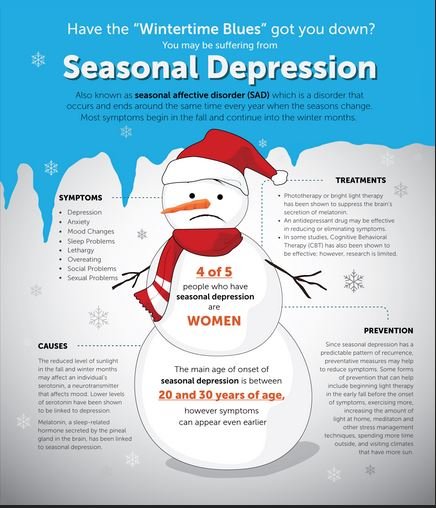Winter got ya down? Understanding Seasonal Affective Disorder (SAD)
As the days grow shorter and the temperatures drop, many people find themselves facing more than just chilly weather. While Seasonal Affective Disorder (SAD) can occur in the winter or in the summer, this article will focus on the "winter blues." This type of depression can occurs during the fall and winter months when there is less sunlight. Let’s explore what SAD is, its symptoms, potential causes, and tools to manage this condition
SAD affects 5% of the population and up to 20% experience milder symptoms.
The symptoms can start at any age, but the average age of onset is between 20 and 30 years of age.
4 out of 5 people that suffer from SAD are women…great.
Symptoms of SAD:
The symptoms of Seasonal Affective Disorder are similar to those of major depressive disorder and may include:
Persistent feelings of sadness or despair
Loss of interest or pleasure in activities
Changes in sleep patterns, such as oversleeping or difficulty sleeping
Changes in appetite, often leading to weight gain
Fatigue and low energy levels
Difficulty concentrating and making decisions
Withdrawal from social activities and relationships
Irritability
Causes of SAD:
Reduced sunlight exposure: Limited exposure to natural sunlight can affect the body's internal clock (circadian rhythm) and disrupt the balance of neurotransmitters like serotonin and melatonin and the hormone cortisol.
Biological /Genetic factors: Individuals with a family history of depression or bipolar disorder may be more susceptible to developing SAD.
Chemical imbalances: Changes in serotonin and melatonin levels play a crucial role in regulating mood and sleep-wake cycles.
Coping Strategies and Treatment:
Sunlight exposure: Maximizing exposure to natural sunlight by spending time outdoors during daylight hours, even on cloudy days, can be beneficial.
Light therapy (phototherapy): Exposure to bright, artificial light that mimics natural sunlight can help regulate mood and alleviate symptoms. Light boxes are commonly used for this purpose.
Lifestyle: Daily movement/exercise, a balanced/nutrient-dense diet, hydration, and maintaining a consistent sleep schedule can contribute to overall well-being and help manage SAD symptoms.
Counseling and psychotherapy: Cognitive-behavioral therapy (CBT) and other forms of psychotherapy can be effective in treating SAD by addressing negative thought patterns and providing coping strategies.
Medication: In some cases, antidepressant medications may be prescribed to help manage symptoms.
Seasonal Affective Disorder is a real and challenging condition that affects individuals during specific times of the year. Understanding the symptoms, causes, and available treatments is crucial for those grappling with SAD and for their friends and family. If you or someone you know is experiencing symptoms of Seasonal Affective Disorder, seeking professional help is important for proper diagnosis and effective management. With the right support and strategies, it's possible to navigate the winter blues and emerge into the brighter days ahead.



